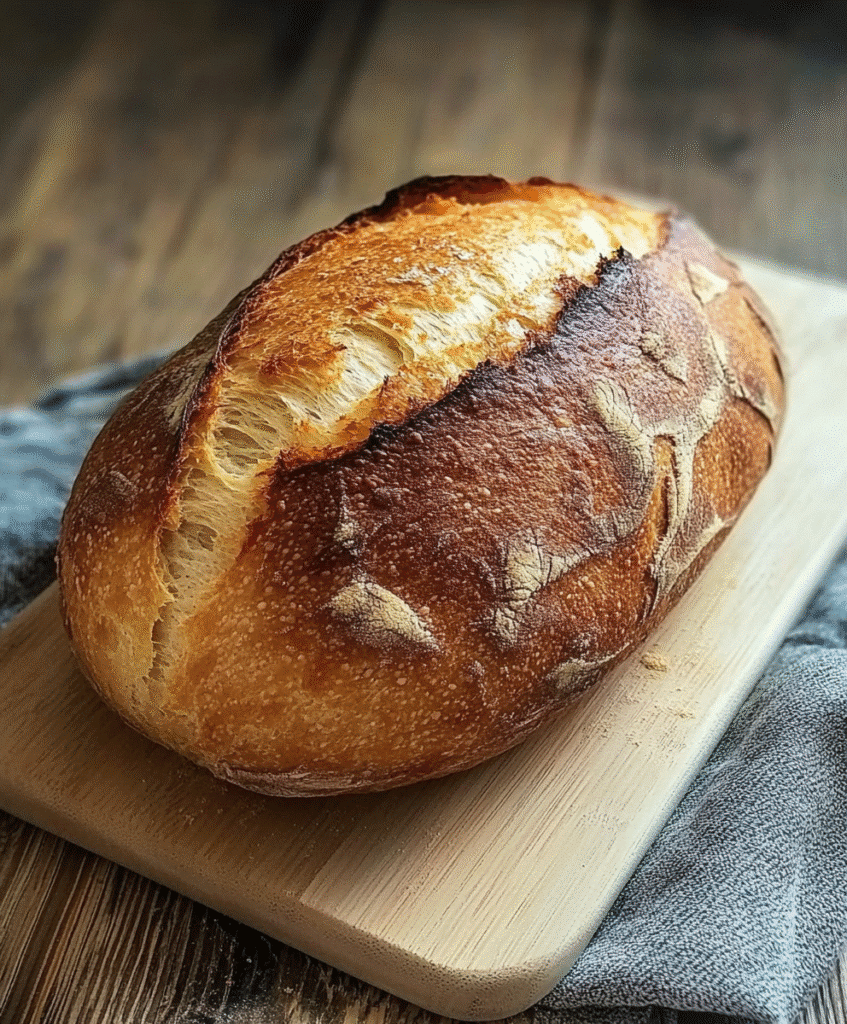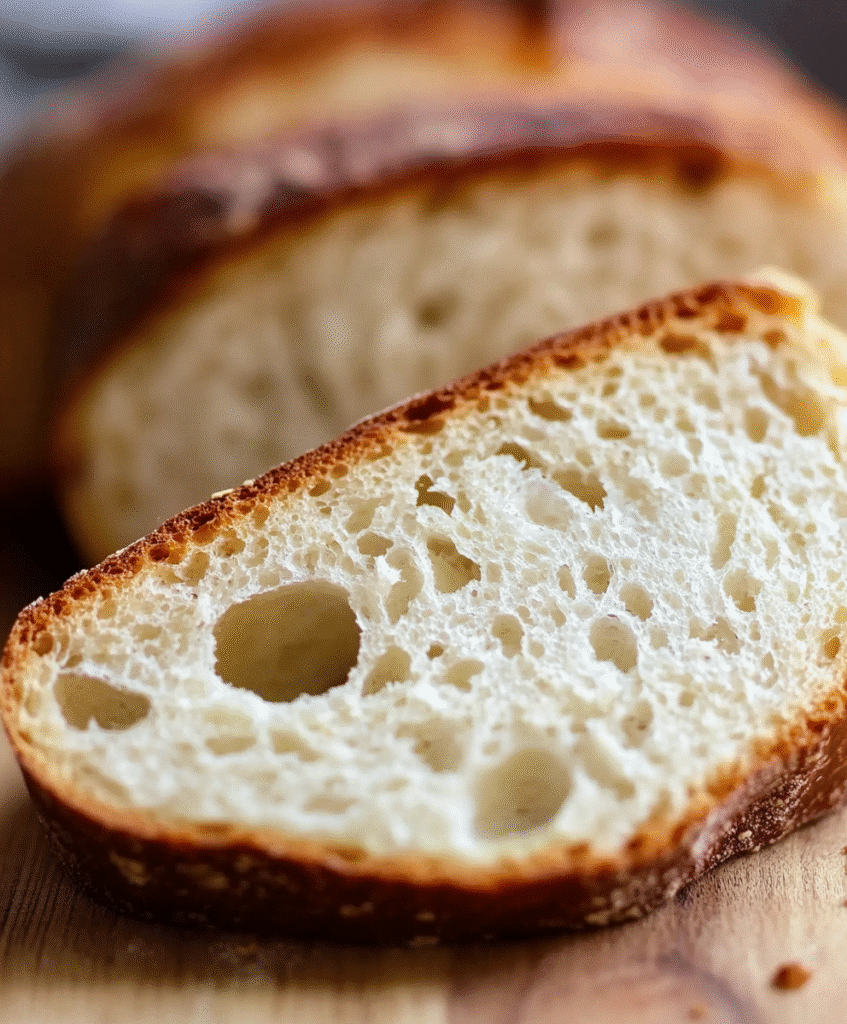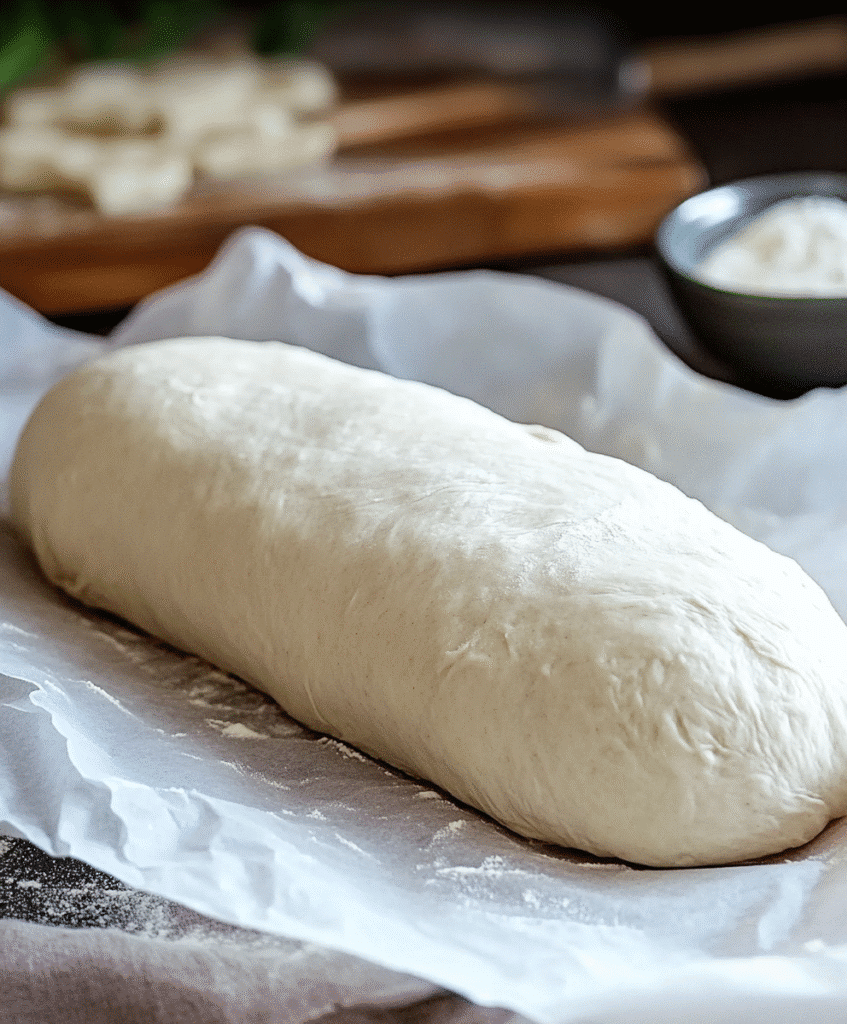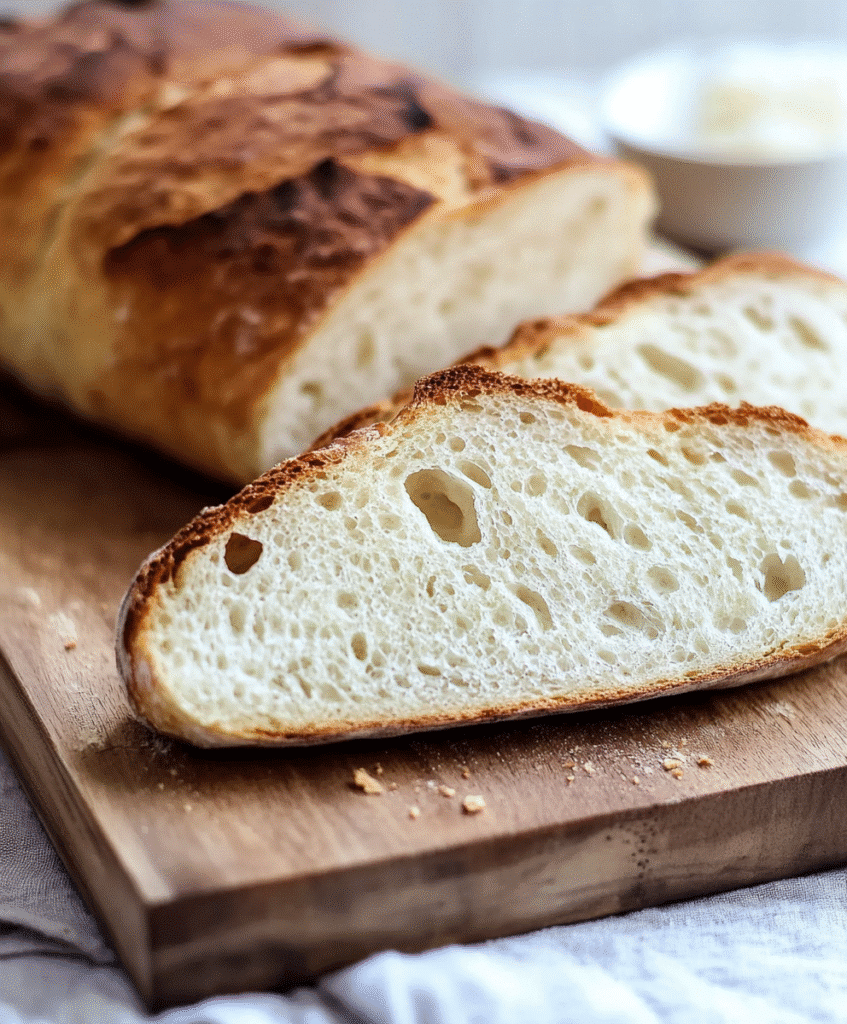Fabulous Italian bread gluten free isn’t just a modern twist—it’s a heartfelt return to the flavors that shaped our childhood. I still remember the magic of watching dough rise on my grandmother’s kitchen counter, the smell of fresh bread wafting through her warm, tiny home, and the joy of tearing off a piece before it even cooled. We’d dip it in rich olive oil or use it to soak up the last spoonfuls of homemade tomato sauce. Back then, bread was comfort, connection, and celebration.
When I first had to give up gluten, it felt like I was losing those traditions. Regular bread just didn’t sit right anymore. Store-bought gluten-free loaves tasted like cardboard, and honestly, they didn’t feel like real bread. That’s what pushed me to explore the world of gluten-free baking, determined to recreate that fabulous Italian bread experience—just without the gluten. And here we are.
In this article, we’re diving deep into how to make fabulous Italian bread gluten free—the kind that’s fluffy inside, crisp on the outside, and flavorful enough to serve at any Italian table. From recipe tips to health benefits, cultural trends, and gluten-free innovations, this is your go-to guide to bringing authentic Italian bread back to your gluten-free kitchen.
Looking for inspiration? Try our gluten-free sourdough bread to deepen your bread-making skills with long fermentation.

Table of Contents
Table of Contents
Why Fabulous Italian Bread Gluten Free Matters More Than Ever
The Gluten-Free Revolution: Why Now?
Over the past decade, gluten-free living has moved from fringe diet trend to mainstream necessity. With more people being diagnosed with celiac disease, gluten intolerance, or choosing gluten-free for wellness reasons, traditional foods like Italian bread needed a serious makeover. That’s where fabulous Italian bread gluten free comes in—not just as a substitute, but as a celebration of what gluten-free bread can truly be.
People want to enjoy bread again—without the bloat, the brain fog, or the stomach cramps. And now, thanks to better flour blends, ingredients like psyllium husk and dairy-free milk, and precise baking techniques, they absolutely can.
Italian Bread: A Gluten-Free Reinvention of a Classic
Italian bread is more than carbs—it’s history, it’s love, it’s tradition. From crusty batards to fluffy focaccia, these loaves have always been a staple in Italian homes. The challenge? Gluten is what gives that chewy texture and airiness.
But today’s gluten-free bakers have cracked the code. By blending ingredients like superfine rice flour, psyllium husk, and melted butter (or dairy-free alternatives), you can recreate that same iconic structure and flavor. And the result? A fabulous Italian bread gluten free that tastes like home—without the gluten crash afterward.

Fabulous Italian Bread Gluten Free – A Delightful Classic Reinvented
Ingredients
Method
- Mix Dry IngredientsWhisk together flour, sugar, salt, yeast, and psyllium husk in the bowl of a stand mixer.
- Add Wet IngredientsSlowly pour in milk and melted butter. Use dough hook on medium-high for 5 minutes until sticky dough forms.
- First RiseCover bowl with wrap and rise in a warm spot for 1–2 hours.
- Cold FermentationRefrigerate for 6–24 hours. Chilling helps flavor and makes dough easier to handle.
- Shape Your LoafFlour your surface and shape dough into a batard, boule, or mini baguettes.
- ProofLet rest at room temp for 30–60 minutes. Preheat oven to 450°F with pizza stone or steel.
- Bake with SteamSlash loaf, place in oven. Add hot water to steam pan. Bake 30–35 minutes.
- Cool CompletelyLet cool on a rack. Don’t cut while warm or it will compress the crumb.
Nutrition
Notes
Tried this recipe?
Let us know how it was!What Makes Italian Bread Fabulous – Even Without Gluten
The Heart of Traditional Italian Bread
Before we can truly appreciate what makes fabulous Italian bread gluten free, we need to understand what makes Italian bread, well… fabulous in the first place. Traditional Italian loaves are prized for their rustic crusts, light chew, and flavorful interior. Ingredients are minimal—typically flour, water, yeast, and salt—but the magic lies in the method. Long rises, natural fermentation, and the art of shaping give each loaf its distinct character.
The result is a bread that’s more than just food—it’s a sensory experience. The crunch of the crust, the soft pull of the crumb, and the rich flavor make it a staple in every Italian household.
But what happens when gluten is removed from that equation? Can you still achieve the same texture, flavor, and beauty?
Absolutely. With the right techniques and ingredients, Italian bread gluten free can be just as incredible—if not better.
Recreating the Magic Without Gluten
Here’s the deal: gluten is what gives traditional bread its structure and elasticity. It’s the protein that traps air bubbles and lets dough rise without collapsing. Take it out, and you’re working with something that acts more like a batter than a dough.
So, how do we recreate fabulous Italian bread gluten free?
It starts with a custom flour blend. Store-bought mixes often fall short. You’ll want to use a combination of superfine white rice flour, starches (like tapioca or potato), and sometimes protein powders. Kim’s gluten-free flour blend from the source recipe is a great example—it’s carefully balanced to mimic gluten’s structure.
Then comes psyllium husk, the MVP of gluten-free baking. It binds ingredients, improves texture, and gives bread that stretch we thought was lost. Add in instant yeast, a touch of sugar, salt, and warm milk (dairy or dairy-free), and you’re ready to mix.
Butter (or a vegan alternative) brings richness and softness to the crust, while a slow overnight rise adds depth of flavor. Steam during baking creates that signature crisp crust—just like the loaves cooling in Nonna’s window.
Don’t miss our easy 4-ingredient gluten-free biscuits—perfect for mornings or savory side dishes.

Italian bread gluten free vs Regular Bread
Key Texture and Flavor Differences
When comparing traditional bread to fabulous Italian bread gluten free, most people expect major compromises. That used to be true—but not anymore. Thanks to innovations in gluten-free baking, today’s loaves rival their wheat-based counterparts in taste and texture.
So, what’s different?
Gluten-based bread relies on the stretchy network formed by gluten proteins. That’s what allows it to trap air, rise high, and form chewy, elastic crumbs. The crust crisps up beautifully, while the interior remains light and spongy.
Italian bread gluten free, by contrast, builds its structure through clever substitutes—like psyllium husk, protein powders, and starchy flours. While the dough may be more fragile and sticky before baking, the final result is surprisingly similar. When done right, the crumb is soft and moist, with a crust that crackles slightly under pressure. Some even prefer the gentler, less dense bite of gluten-free bread.
The flavor? That’s where this fabulous Italian bread shines. Thanks to the long fermentation and subtle sweetness from sugar or honey, the taste is complex, nutty, and deeply satisfying. Many gluten-free bakers add herbs like rosemary, garlic, or sea salt to enhance the Italian profile.
Nutritional Comparison: Gluten-Free vs Traditional Italian Bread
Let’s break it down:
| Feature | Regular Italian Bread | Fabulous Italian Bread Gluten Free |
|---|---|---|
| Contains Gluten | Yes | No |
| Fiber Content | Moderate | Often higher with psyllium husk |
| Protein Level | Higher (from gluten) | Balanced with protein powder |
| Crust Texture | Thick and chewy | Crisp but thinner |
| Glycemic Index | Moderate to High | Varies (can be lower with tweaks) |
| Shelf Life | 2–3 days | 3–4 days, plus freezable |
While gluten-free bread can sometimes lack protein or fiber if made with only starches, recipes like this one incorporate psyllium and thoughtful flour blends to boost the nutritional profile. You’ll often find that it digests easier, leaves you feeling lighter, and avoids the bloat that comes with gluten-heavy loaves.
The Recipe Breakdown – Making Fabulous Italian Bread Gluten Free at Home
Ingredients: From Psyllium Husk to Dairy-Free Milk
To make truly fabulous Italian bread gluten free, every ingredient plays a crucial role. This isn’t a “dump and bake” situation—you need balance, intention, and the right components. Let’s walk through what you’ll need and why it matters.
Essential Ingredients for Structure and Flavor:
- Gluten-Free Bread Flour Blend: A well-balanced blend (like Kim’s or your own mix using superfine rice flour, tapioca starch, and protein powder) is vital. Skip generic all-purpose GF flours—they often lead to crumbly or gummy results.
- Whole Psyllium Husk: This is your gluten stand-in. It traps moisture, provides elasticity, and creates that stretch you crave in good Italian bread.
- Instant Yeast: Choose rapid-rise or instant yeast for best results. No proofing needed—just mix it right in.
- Milk (or Non-Dairy Milk): Adds tenderness and moisture. Almond milk works beautifully here if you’re dairy-free.
- Butter (or Plant-Based Alternative): Helps soften the crust and adds richness. Melt it before adding.
- Sugar & Salt: Just a touch of both. Sugar feeds the yeast, while salt enhances every flavor.
Optional Add-ins:
- Olive oil, rosemary, or garlic for enhanced Italian authenticity.
- Apple cider vinegar or lemon juice to brighten the dough and improve rise.
Step-by-Step Process for the Perfect Crust and Soft Center
Ready to bake like a pro? Here’s how to make fabulous Italian bread gluten free from scratch:
1. Mix the Dry Ingredients
In your stand mixer bowl, whisk together:
- Bread flour blend
- Psyllium husk
- Salt
- Sugar
- Yeast
2. Add the Wet Ingredients
Pour in warm milk and melted butter. Mix using the dough hook on medium-high for about 5 minutes until sticky dough forms.
3. Bulk Fermentation (Let it Rise)
Cover with plastic wrap. Let it rise for 1–2 hours in a warm spot. The dough will puff slightly—not double like gluten bread.
4. Cold Fermentation (Refrigeration)
Place the bowl in the fridge overnight (or at least 6 hours). This makes shaping easier and enhances flavor.
5. Shape the Loaf
Dump the dough onto a floured surface. Use a bench scraper and floured hands to form a batard or boule. Transfer to parchment.
6. Proof
Let it sit for 30–60 minutes at room temperature, covered loosely. Preheat the oven to 450°F during this time, with a pizza stone or baking sheet inside.
7. Bake with Steam
Slash the top with a lame or sharp knife. Transfer to the hot stone. Pour hot water into a pan below for steam. Bake 30–35 minutes.
8. Cool and Serve
Cool on a rack. The crust will soften as it cools. Once cool, slice and enjoy with olive oil, soup, or your favorite sandwich filling.
Check out our gluten-free pancake recipe—fluffy, simple, and great with homemade butter.

Troubleshooting Your Gluten-Free Dough
Common Problems with Gluten-Free Dough and How to Fix Them
Even the most fabulous Italian bread gluten free can hit a few speed bumps if you’re new to gluten-free baking. Don’t worry—every baker runs into issues. Here’s how to solve the most common problems with gluten-free bread dough.
1. Too Sticky to Handle
Gluten-free dough often feels more like a thick batter than a typical elastic dough. This is normal—but if it’s overly wet:
- Chill the dough longer (overnight is best).
- Add 1–2 tablespoons of flour during shaping, not during mixing.
- Use olive oil on your hands and tools to reduce sticking.
2. Flat or Dense Loaves
If your bread didn’t rise well or collapsed during baking, consider:
- Yeast freshness – Test it in warm water to make sure it’s active.
- Overproofing – GF dough doesn’t need to double like regular bread. Overproofed dough loses structure fast.
- Too much liquid – Re-check flour ratios. If using a different blend, adjust the hydration slightly.
3. Gummy or Undercooked Center
This one’s a classic with gluten-free loaves. If your bread feels raw inside even after baking:
- Use a thermometer – Internal temp should hit 205–210°F.
- Bake longer – Tent with foil to prevent overbrowning and add 5–10 minutes.
- Cool completely – Cutting too soon can trap steam and lead to a gummy center.
Tips on Hydration, Flour Blends, and Proofing
One reason this fabulous Italian bread gluten free works so well is the hydration strategy. Moisture makes or breaks a gluten-free recipe.
Hydration Tips:
- Use psyllium husk to absorb water and lock in structure.
- Avoid subbing flours 1:1 without adjusting liquid content.
- Don’t be afraid of a sticky dough—it’s meant to be that way pre-bake.
Flour Blend Reminders:
- Always use superfine rice flour when blending.
- Avoid gritty or overly absorbent flours like brown rice unless specified.
- If your blend includes xanthan gum or guar gum, reduce psyllium slightly.
Proofing Guidance:
- First rise (bulk fermentation): 1–2 hours at warm room temp.
- Second rise (proof): 30–45 minutes only—don’t overdo it.
- Use a warm oven (off with light on) or proofing drawer to maintain a draft-free environment.
Variations and Twists on the Classic Recipe
How to Make Fabulous Italian Bread Gluten Free in New Styles
Once you’ve mastered the base version of fabulous Italian bread gluten free, it’s time to explore new flavors, styles, and forms. Just because it’s gluten-free doesn’t mean it has to be basic. In fact, with a few tweaks, you can recreate nearly every Italian bread style—without sacrificing taste or texture.
Let’s dive into the most-loved variations:
Gluten-Free Focaccia
Focaccia is a classic Italian flatbread, known for its dimpled texture and herby flavor. To transform your fabulous Italian bread gluten free dough into focaccia:
- Spread the chilled dough into a greased, parchment-lined pan.
- Use oiled fingers to create dimples.
- Drizzle with olive oil and top with sea salt, rosemary, or roasted garlic.
- Bake at 425°F for 25–30 minutes.
Focaccia made this way is soft in the middle, crispy at the edges, and fully gluten-free without losing authenticity.
Boules, Baguettes & Rolls
Shape your dough into round boules or short baguettes by dusting a surface heavily with flour. Use a bench scraper to help you lift and turn sticky dough. For rolls, divide and round into small mounds.
Adjust baking times:
- Boules: 30–35 minutes
- Rolls: 18–22 minutes
- Mini baguettes: 25 minutes
All styles begin with the same base: the fabulous Italian bread gluten free dough.
Herb-Infused, Dairy-Free, and Vegan Options
Dairy-free? Vegan? No problem. The base dough is naturally egg-free, and you can make simple swaps:
- Use almond, oat, or soy milk instead of dairy milk.
- Sub plant-based butter (like Earth Balance) for regular butter.
Flavor additions:
- Fresh rosemary or basil
- Sun-dried tomatoes
- Roasted garlic
- Vegan Parmesan (for a cheesy kick)
For sweeter variations, try adding honey, a touch of cinnamon, or raisins. Yes—sweet Italian bread is a thing, and it’s fabulous.
Is Gluten-Free Italian Bread Good for You?
Health Benefits of Fabulous Italian Bread Gluten Free
People often ask, “Is fabulous Italian bread gluten free healthier than regular bread?” The short answer: it can be. Especially when it’s made at home with the right ingredients, gluten-free bread offers digestive ease and fewer inflammatory effects—especially for people with celiac disease or gluten sensitivity.
Here’s how this gluten-free option stacks up nutritionally:
- Easier on the gut: Without gluten, you’re less likely to experience bloating, cramping, or fatigue after eating.
- Less processed than store-bought: Homemade versions like this fabulous Italian bread gluten free recipe skip the stabilizers and preservatives found in commercial brands.
- Customizable: Add fiber-rich ingredients like flax, chia, or psyllium husk to support digestion and heart health.
- Balanced carbs: You can tweak the flour blend to include lower-glycemic options like sorghum or buckwheat flour.
That said, “gluten-free” doesn’t automatically mean “healthy.” The health factor depends on:
- Quality of ingredients
- Baking method
- Portion control (yes, even with gluten-free bread!)
What Nutrients You Might Miss and How to Supplement
One downside of a gluten-free diet is the risk of missing key nutrients that are often found in enriched wheat products. Here’s what to watch out for and how to compensate:
| Nutrient | Role in the Body | Gluten-Free Replacement Ideas |
|---|---|---|
| Iron | Oxygen transport | Lentils, pumpkin seeds, spinach |
| B Vitamins | Energy, nerve support | Nutritional yeast, eggs, fortified cereals |
| Fiber | Digestion, fullness | Psyllium husk, flaxseeds, quinoa |
| Zinc | Immune function | Chickpeas, sunflower seeds |
Adding ingredients like flaxseed meal or a spoonful of chia seeds into your fabulous Italian bread gluten free dough is a simple and tasty way to fill those gaps.
Bonus: many gluten-free bread flours can be pre-enriched or combined with protein powders to balance macronutrients better than traditional white flour breads.
Learn more in our gluten-free chicken tenders recipe—crispy, family-friendly, and easy to make.
Cultural Trends – Are More Italians Going Gluten-Free?
Gluten-Free Living in Italy: A Growing Movement
Once upon a time, the idea of fabulous Italian bread gluten free might’ve sounded like culinary heresy in Italy. Bread is sacred in Italian culture—from ciabatta to focaccia to pane toscano. But today, even in the heart of Rome or the streets of Florence, gluten-free bakeries are on the rise.
Italy has one of the highest rates of diagnosed celiac disease in Europe. As awareness has grown, so has access to gluten-free foods. Italian supermarkets now stock certified gluten-free flours, pastas, and even fresh bread. Restaurants are adapting too—offering gluten-free versions of everything from pizza to panini.
The country even passed a law requiring restaurants that advertise “gluten-free” to meet rigorous safety standards. It’s not just about trend—it’s about public health, and Italians are taking it seriously.
What once was rare is now respected.
How Fabulous Italian Bread Gluten Free Fits into Italian-American Homes
Here in the U.S., where heritage recipes meet modern lifestyles, many Italian-American households are embracing gluten-free alternatives while staying true to flavor and tradition.
In fact, more Italian-American families are baking at home—not only to control ingredients, but to preserve the spirit of Italian bread in a way that’s accessible to everyone at the table.
Fabulous Italian bread gluten free has become a centerpiece at holidays, Sunday dinners, and neighborhood potlucks. It proves that tradition doesn’t have to come with discomfort—and that food made with care, even without gluten, still tells a story.
You’ll find:
- Grandmas learning new flour blends
- Dads perfecting their rise techniques
- Kids eating GF bruschetta like it’s a pizza party
And that’s the beauty of this journey: gluten-free no longer means giving up—it means getting creative, connecting with your roots, and sharing food that nourishes and delights.
Serving and Storing Fabulous Gluten-Free Italian Bread
Best Ways to Enjoy Fabulous Italian Bread Gluten Free
You’ve just pulled your fabulous Italian bread gluten free loaf from the oven. It’s golden, aromatic, and calling your name. So how should you serve it? This bread is versatile—it fits everything from rustic dinners to refined appetizers.
Here are a few classic (and creative) ways to enjoy it:

Everyday Serving Ideas:
- With Olive Oil & Balsamic: Drizzle with fruity EVOO and a touch of balsamic for a Tuscan-style starter.
- Gluten-Free Bruschetta: Toast slices, rub with garlic, and top with tomatoes, basil, and olive oil.
- Deli-Style Sandwiches: Use it for hearty subs or paninis—especially with Italian meats or grilled veggies.
- Soup Sidekick: Pair with minestrone, tomato bisque, or lentil soup.
- Breakfast Toast: Top with avocado, almond butter, or dairy-free cream cheese.
How to Store and Keep It Fresh
Let’s make that fabulous texture last beyond Day One. Unlike preservative-heavy commercial bread, homemade gluten-free loaves need special care to stay fresh.
Room Temperature:
- Store in a zip-top bag or wrapped in foil for up to 2 days.
- Keep at cool room temp, away from heat or direct sunlight.
- To soften a day-old loaf, wrap in foil and warm in a 350°F oven for 10 minutes.
Freezing:
- Slice the bread first.
- Wrap tightly in plastic wrap, then foil, and freeze for up to 2 months.
- Reheat by placing slices directly in toaster or oven.
Pro Tip:
Refresh frozen bread by running slices under cold water and placing in a hot oven for 5–10 minutes. The moisture + heat combo brings it back to bakery-level freshness.
Conclusion: Fabulous Italian Bread Gluten Free Isn’t Just Possible—It’s Phenomenal
If you’ve made it this far, you now know that fabulous Italian bread gluten free isn’t a compromise—it’s a triumph. From the aroma of warm dough rising in your kitchen to that first crisp, golden bite, this bread brings back everything you loved about traditional Italian loaves—without the gluten.
Whether you’re baking for health reasons, for someone you love, or just because you miss that classic Italian texture and flavor, this gluten-free version delivers. It’s fluffy, crusty, rich in flavor, and fully customizable. Best of all, it brings joy back to the table—exactly where it belongs.
Don’t settle for dry, bland store-bought options when you can create bakery-worthy bread right at home. With the right ingredients, a bit of patience, and this guide by your side, your next gluten-free loaf could become a new family tradition.
Don’t miss our gluten-free banana nut bread muffins—moist, naturally sweet, and bakery-worthy.
Follow us on Facebook & Pinterest for more gluten-free dessert ideas and community fun!
FAQs About Fabulous Italian Bread Gluten Free
Does Italian bread have gluten?
Yes, traditional Italian bread contains gluten because it’s made with wheat flour, which is naturally rich in gluten. However, fabulous Italian bread gluten free is made using gluten-free flour blends and substitutes like psyllium husk to replicate that same airy texture and delicious crust—without the gluten.
What bread is naturally gluten-free?
Naturally gluten-free breads are typically made with ingredients like rice, corn, buckwheat, or millet. Some ancient grain loaves, like teff or sorghum, are also gluten-free by nature. That said, most Italian-style bread—including fabulous Italian bread gluten free—requires specially formulated flour blends to mimic traditional wheat-based dough.
Are a lot of Italians gluten-free?
Yes, Italy has one of the highest diagnosed rates of celiac disease in Europe. The country takes gluten-free dining seriously—with strict regulations and widespread availability of gluten-free foods, including pizza, pasta, and now gluten-free Italian bread in both stores and restaurants.
Is there gluten-free focaccia?
Absolutely. Gluten-free focaccia is a popular variation of fabulous Italian bread gluten free. With olive oil, herbs, and a soft center, this bread style is ideal for dipping or serving alongside meals. It can be made from the same dough base as gluten-free Italian bread—just pressed into a pan and baked slightly shorter.
Is sourdough OK for gluten-free?
Only if it’s made with gluten-free ingredients. While traditional sourdough fermentation can slightly reduce gluten content, it’s not safe for those with celiac disease unless the flour itself is gluten-free. Luckily, you can make a sourdough version of fabulous Italian bread gluten free using a gluten-free starter and similar fermentation methods.
